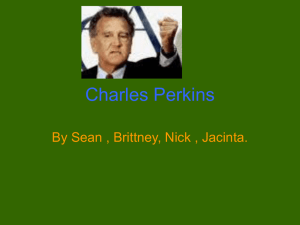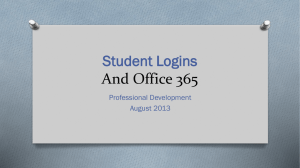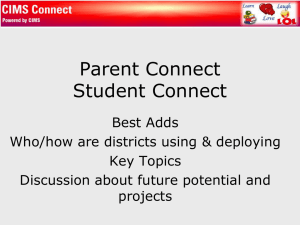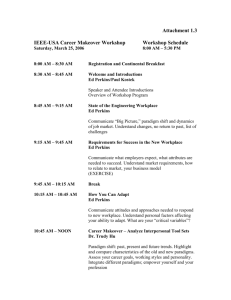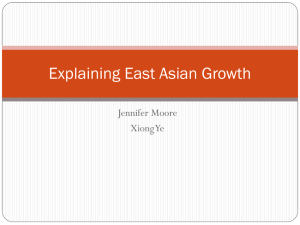LabStats: Public computer usage analysis, Jan 2013
advertisement
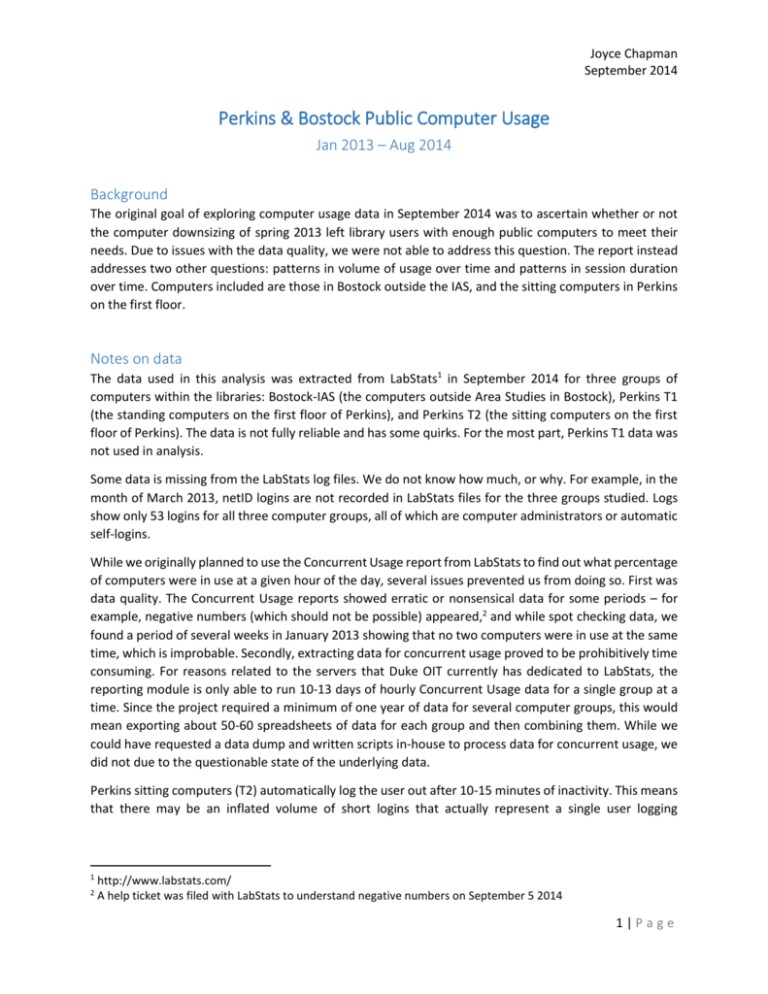
Joyce Chapman September 2014 Perkins & Bostock Public Computer Usage Jan 2013 – Aug 2014 Background The original goal of exploring computer usage data in September 2014 was to ascertain whether or not the computer downsizing of spring 2013 left library users with enough public computers to meet their needs. Due to issues with the data quality, we were not able to address this question. The report instead addresses two other questions: patterns in volume of usage over time and patterns in session duration over time. Computers included are those in Bostock outside the IAS, and the sitting computers in Perkins on the first floor. Notes on data The data used in this analysis was extracted from LabStats1 in September 2014 for three groups of computers within the libraries: Bostock-IAS (the computers outside Area Studies in Bostock), Perkins T1 (the standing computers on the first floor of Perkins), and Perkins T2 (the sitting computers on the first floor of Perkins). The data is not fully reliable and has some quirks. For the most part, Perkins T1 data was not used in analysis. Some data is missing from the LabStats log files. We do not know how much, or why. For example, in the month of March 2013, netID logins are not recorded in LabStats files for the three groups studied. Logs show only 53 logins for all three computer groups, all of which are computer administrators or automatic self-logins. While we originally planned to use the Concurrent Usage report from LabStats to find out what percentage of computers were in use at a given hour of the day, several issues prevented us from doing so. First was data quality. The Concurrent Usage reports showed erratic or nonsensical data for some periods – for example, negative numbers (which should not be possible) appeared,2 and while spot checking data, we found a period of several weeks in January 2013 showing that no two computers were in use at the same time, which is improbable. Secondly, extracting data for concurrent usage proved to be prohibitively time consuming. For reasons related to the servers that Duke OIT currently has dedicated to LabStats, the reporting module is only able to run 10-13 days of hourly Concurrent Usage data for a single group at a time. Since the project required a minimum of one year of data for several computer groups, this would mean exporting about 50-60 spreadsheets of data for each group and then combining them. While we could have requested a data dump and written scripts in-house to process data for concurrent usage, we did not due to the questionable state of the underlying data. Perkins sitting computers (T2) automatically log the user out after 10-15 minutes of inactivity. This means that there may be an inflated volume of short logins that actually represent a single user logging 1 2 http://www.labstats.com/ A help ticket was filed with LabStats to understand negative numbers on September 5 2014 1|Page Joyce Chapman September 2014 themselves back in several times over the course of a longer period of time working at a station. We do not currently know what percentage of short logins actually represent longer sessions. We originally planned to include the standing public computers on the first floor of Perkins in our analysis, but later realized we do not have accurate usage data for this group (Perkins T1). This is because the standing computers do not require a login; they automatically log themselves in each morning and are then available for anyone to use. Therefore, analyzing “logins” for Perkins T1 computers does not in any way correspond to usage rates. Computer session duration data for 10 hours or longer was discarded from the entire dataset with the assumption that it represented an error in the data. Analysis Volume of logins The volume of computer logins was analyzed for Perkins T2 (sitting computers) and for the computers outside of IAS in Bostock. Login volume was analyzed by time of day, day of the week, and across years. From January 2013 through August 2014 there were approximately 35,000 logins recorded on these two sets of computers. Ninety-eight percent (34,381) of these took place on the Perkins computers and 2% (734) took place on the Bostock computers. All of the charts below show logins and sessions based on percentages instead of by volume in order to facilitate trend comparison. Time of day Overall, computer usage peaks just after lunch, from 1-2:59pm, when 20% of all logins occur. Forty-six percent of all logins occur between 11am-3:59pm, and three-quarters of all logins occur between 9am5:59pm. Slight variations are seen in this pattern when we observe Bostock IAS and Perkins T2 computers separately (below). While both locations experience a dip during lunch (12-12:59pm), Bostock IAS 2|Page Joyce Chapman September 2014 computers experience a steeper drop than Perkins T2 computers; Bostock also experiences a higher percentage of post-lunch logins. The only other difference in computer logins by hour of the day is a slight spike in Bostock logins at 8-8:59pm. Keep in mind that Perkins computers experienced 47 times more usage than Bostock computers. Day of the week We see fairly evenly distributed login volume across weekdays: Monday through Thursday each receive 17-18% of logins, with a slight dip on Friday to 15%, roughly half as many logins on the weekend as the weekdays. 3|Page Joyce Chapman September 2014 Bostock and Perkins show similar patterns in login by day of the week. The only difference is that Bostock experiences slightly higher volume of logins on Saturdays (9%) than Sundays (6%). By month When the data is analyzed by month over the course of 1.5 years, we see expected dips in usage during the summers and December. The apparent lack of logins in March 2013 is due to missing data for that month. Logins appear to increase over the course of the spring semester in 2013 (though the missing March data makes this somewhat difficult to see), but the pattern reverses for spring 2014: logins peak in January and decrease throughout the semester. We would typically expect the patterns for spring semesters to be similar year to year [was something different about the computer placement, building hours, geography of the building, etc. that might have caused a change?]. While we only have one semester’s worth of fall data to observe, we can see that logins climb from August through September and then decrease through December. Duration of logins Duration data for Perkins first floor standing computers is not included in analysis because these computers do not require logins and therefore cannot accurately track sessions or users. Fifty percent of all computer sessions are under half an hour, with 25% lasting 0-10 minutes and 25% lasting 11-30 minutes. Fifteen percent of all sessions lasted two hours or longer. 4|Page Joyce Chapman September 2014 The chart below shows computer session durations broken out by location. With Perkins T2 accounting for 98% of all sessions and Bostock IAS accounting for only 2%, it is clear that the majority of brief sessions are occurring at the Perkins T2 computers. Without taking session volume into account, 0-10 minutes sessions are twice as likely to occur in Perkins T2 as in Bostock IAS, and at the Bostock IAS computers sessions are just as likely to last 3-6 hours as they are 30 minutes or 1 hour. All of these lengthier sessions are more likely than a 0-10 minute one in Bostock. Very long sessions (6-9 hours) occur four times as frequently among Bostock IAS computers when session volume is not taken into account than among Perkins T2 computers. Similarly, 3-6 hour sessions occur three times more frequently in Bostock. The chart on the following page shows session duration by hour of the day. The hour shown on the chart is the hour in which the session began. There is a small peak in 6-9 hour sessions that begins at 1:00am. Very short sessions (0-10) minutes following a spiking pattern: at 9:00am, 11:00am, 2:00pm, and 4:00pm. 1-2 hour sessions follow a similar spiking pattern: at 11:00am, 1:00pm, and 3:00pm. 5|Page Joyce Chapman September 2014 3-6 hour sessions see a high point beginning at 1:00pm Many of the lines taper more sharply in the late afternoon but then pick back up again for a smaller second wind in the evening Applications usage Fifty-six percent of all application launches on the three groups of computers is for web browsers: 39% Internet Explorer and 17% Firefox. The second most popular application is Adobe reader, with 26% of all application launches. Third is Microsoft Word, with 11% of launches. Overall, only six applications are used enough to garner 1% or more of the total for a single computer group. These are shown below. 6|Page
